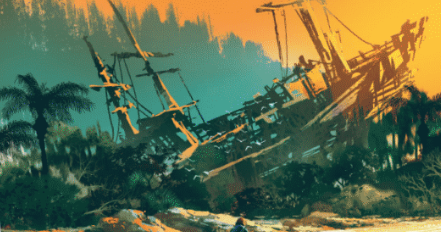Castaways
Maritime lore is filled with tales of sailors who found themselves stranded on deserted islands with seemingly no hope of rescue. In each case, these castaways faced a constant fight for survival against hunger, wild animals, severe weather and sheer loneliness. Below are two incredible stories of people who were stranded in unforgiving territory and lived to tell the tale. Alexander Selkirk was a Scottish sailor and a skilful navigator, which led to his appointment as a Sailing Master. The captain of his ship was a tyrant , and, after a few sea battles with the Spanish, Selkirk feared the ship would sink. Thus, in an attempt to save his own life, he demanded to be put ashore on the next island they encountered . In September 1704, Selkirk was dropped off on the uninhabited island of Más a Tierra, over 644km off the West Coast of Chile. He took with him some clothing, a musket , some tools, a book and some food. At first, Selkirk simply read his book while awaiting rescue, but it soon became apparent that no rescue was imminent . He resigned himself to a long stay, and began to make island life habitable with only rats, goats and cats for company. Finally, in February 1709, two British privateers dropped anchor offshore and Alexander Selkirk was rescued. In 1713, Selkirk published an account of his adventures, which many believe were fictionalized six years later by Daniel Defoe in his now famous novel: Robinson Crusoe . Ernest Shackleton was an Anglo-Irish explorer who launched the Imperial Trans-Antarctic Expedition in 1914. During the expedition, the ship “Endurance” became trapped in ice and drifted until the pressure of the ice crushed and sank it. Shackleton and his men were stranded on ice floes, where they camped for five months. The men sailed three small lifeboats to Elephant Island, which was uninhabited and provided no hope for rescue. Shackleton and five others set out to take the crew’s rescue into their own hands. In a seven metre lifeboat, they survived a 17-day, 1,290km journey through the world’s worst seas to South Georgia Island, where a whaling station was located. The six men landed on an uninhabited part of the island, so their last hope was to cross 42km of mountains and glaciers (considered impassable ) to reach the whaling station on the other side. Shackleton and two others made the trek and arrived safely in August 1916 (21 months after the initial departure of the Endurance). With the help of the Chilean government and its navy, Shackleton returned to rescue the men on Elephant Island. Not one member of the 28-man crew was lost. (Reading text adapted from listverse)

